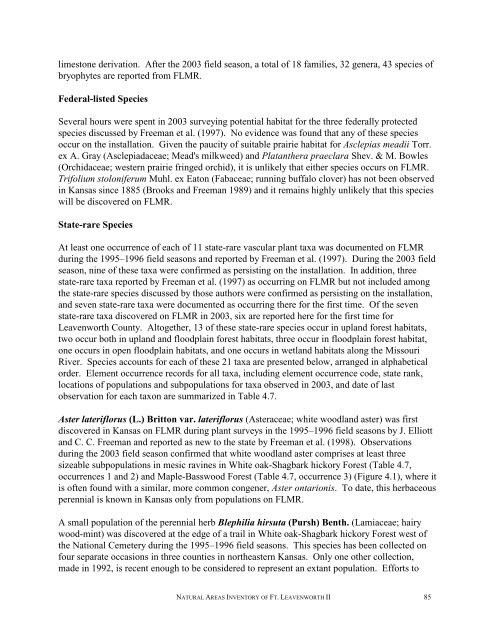A Natural Areas Inventory of the - Kansas Natural Heritage Inventory ...
A Natural Areas Inventory of the - Kansas Natural Heritage Inventory ...
A Natural Areas Inventory of the - Kansas Natural Heritage Inventory ...
You also want an ePaper? Increase the reach of your titles
YUMPU automatically turns print PDFs into web optimized ePapers that Google loves.
limestone derivation. After <strong>the</strong> 2003 field season, a total <strong>of</strong> 18 families, 32 genera, 43 species <strong>of</strong><br />
bryophytes are reported from FLMR.<br />
Federal-listed Species<br />
Several hours were spent in 2003 surveying potential habitat for <strong>the</strong> three federally protected<br />
species discussed by Freeman et al. (1997). No evidence was found that any <strong>of</strong> <strong>the</strong>se species<br />
occur on <strong>the</strong> installation. Given <strong>the</strong> paucity <strong>of</strong> suitable prairie habitat for Asclepias meadii Torr.<br />
ex A. Gray (Asclepiadaceae; Mead's milkweed) and Platan<strong>the</strong>ra praeclara Shev. & M. Bowles<br />
(Orchidaceae; western prairie fringed orchid), it is unlikely that ei<strong>the</strong>r species occurs on FLMR.<br />
Trifolium stoloniferum Muhl. ex Eaton (Fabaceae; running buffalo clover) has not been observed<br />
in <strong>Kansas</strong> since 1885 (Brooks and Freeman 1989) and it remains highly unlikely that this species<br />
will be discovered on FLMR.<br />
State-rare Species<br />
At least one occurrence <strong>of</strong> each <strong>of</strong> 11 state-rare vascular plant taxa was documented on FLMR<br />
during <strong>the</strong> 1995–1996 field seasons and reported by Freeman et al. (1997). During <strong>the</strong> 2003 field<br />
season, nine <strong>of</strong> <strong>the</strong>se taxa were confirmed as persisting on <strong>the</strong> installation. In addition, three<br />
state-rare taxa reported by Freeman et al. (1997) as occurring on FLMR but not included among<br />
<strong>the</strong> state-rare species discussed by those authors were confirmed as persisting on <strong>the</strong> installation,<br />
and seven state-rare taxa were documented as occurring <strong>the</strong>re for <strong>the</strong> first time. Of <strong>the</strong> seven<br />
state-rare taxa discovered on FLMR in 2003, six are reported here for <strong>the</strong> first time for<br />
Leavenworth County. Altoge<strong>the</strong>r, 13 <strong>of</strong> <strong>the</strong>se state-rare species occur in upland forest habitats,<br />
two occur both in upland and floodplain forest habitats, three occur in floodplain forest habitat,<br />
one occurs in open floodplain habitats, and one occurs in wetland habitats along <strong>the</strong> Missouri<br />
River. Species accounts for each <strong>of</strong> <strong>the</strong>se 21 taxa are presented below, arranged in alphabetical<br />
order. Element occurrence records for all taxa, including element occurrence code, state rank,<br />
locations <strong>of</strong> populations and subpopulations for taxa observed in 2003, and date <strong>of</strong> last<br />
observation for each taxon are summarized in Table 4.7.<br />
Aster lateriflorus (L.) Britton var. lateriflorus (Asteraceae; white woodland aster) was first<br />
discovered in <strong>Kansas</strong> on FLMR during plant surveys in <strong>the</strong> 1995–1996 field seasons by J. Elliott<br />
and C. C. Freeman and reported as new to <strong>the</strong> state by Freeman et al. (1998). Observations<br />
during <strong>the</strong> 2003 field season confirmed that white woodland aster comprises at least three<br />
sizeable subpopulations in mesic ravines in White oak-Shagbark hickory Forest (Table 4.7,<br />
occurrences 1 and 2) and Maple-Basswood Forest (Table 4.7, occurrence 3) (Figure 4.1), where it<br />
is <strong>of</strong>ten found with a similar, more common congener, Aster ontarionis. To date, this herbaceous<br />
perennial is known in <strong>Kansas</strong> only from populations on FLMR.<br />
A small population <strong>of</strong> <strong>the</strong> perennial herb Blephilia hirsuta (Pursh) Benth. (Lamiaceae; hairy<br />
wood-mint) was discovered at <strong>the</strong> edge <strong>of</strong> a trail in White oak-Shagbark hickory Forest west <strong>of</strong><br />
<strong>the</strong> National Cemetery during <strong>the</strong> 1995–1996 field seasons. This species has been collected on<br />
four separate occasions in three counties in nor<strong>the</strong>astern <strong>Kansas</strong>. Only one o<strong>the</strong>r collection,<br />
made in 1992, is recent enough to be considered to represent an extant population. Efforts to<br />
NATURAL AREAS INVENTORY OF FT. LEAVENWORTH II 85


